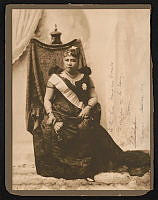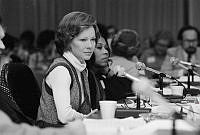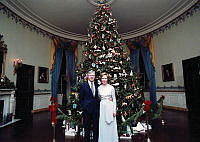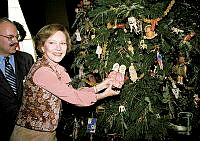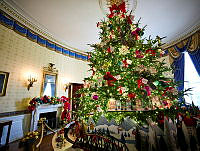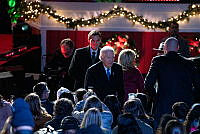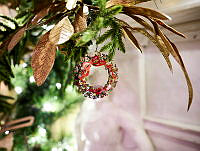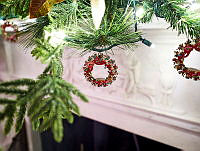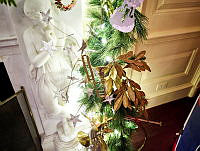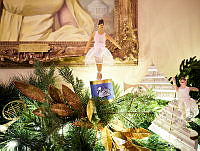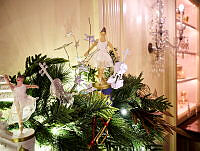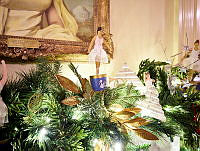Helen Taft

Helen Louise "Nellie" Herron was born on June 2, 1861, in Cincinnati, Ohio. She was the fourth of eleven children born to Harriet Collins Herron and John Williamson Herron. Harriet’s family was politically active in New York with her father and brother serving in Congress, while John at one point operated a law firm with Rutherford B. Hayes.1 Growing up in politics, the future first lady developed an interest in law and campaigning. Helen enrolled in Cincinnati's prestigious Miss Nourse School for Girls where she studied many subjects including English literature and foreign languages, and developed a love for music.2
Helen met William Howard Taft at a sledding party in 1880.3 William and Helen bonded over their shared intellectual interests and married on June 19, 1886. They had three children: Robert (1889), Helen (1891), and Charles (1897).4
Mrs. Taft was a strong supporter of her husband’s political career, even when it required them to move overseas. From 1900 to 1903, the Tafts lived in the Philippines, where William served as the head of the Philippine Commission before becoming governor-general. During this time, Helen contributed by organizing afternoon strolls and introducing concerts, which provided citizens with opportunities to socialize and enjoy the local area.5
When William Howard Taft became president in 1909, the Taft family moved into the White House. Although Helen had been involved in William’s early political career, she admitted that her "very active participation" ended when he became president, as her own duties were "too engrossing" to follow him into the "governmental maze" of presidency.6
Merely two months into her time as first lady, Helen Taft experienced a stroke, limiting her mobility and speech.7 White House social events and obligations were fulfilled by her daughter Helen and sisters Jennie Anderson, Eleanor More, and Maria Herron.8 Despite this illness, Helen Taft stated that even from the Second Floor, she "directed arrangements for social activities" as if she were healthy.9
After her recovery, one of Helen Taft's most notable events as first lady was her and William’s silver (or 25th) anniversary party, held on the White House Grounds with over 5,000 guests. The party brought together politicians and close friends.10
Helen Taft was very interested in workers' rights and held great interest the National Civic Federation where she advocated for improved workplace conditions, leading to her collaboration with Washington leaders, inspections of federal workplaces, and the eventual enactment of Executive Order 1498, which standardized safety and sanitary conditions for workers.11 On March 27, 1912, Helen and Iwa Chinda, the wife of the Japanese ambassador, planted Japanese cherry trees along the Tidal Basin. Helen had first experienced the trees during a trip to Japan while the Tafts were in the Philippines.12 This tradition is still celebrated every spring during the National Cherry Blossom Festival.13 In the same year, Helen donated her inaugural gown to the Smithsonian Institution, which marked the beginning of what is now the collection of First Ladies' gowns at the National Museum of American History.14
When President Taft’s term ended, Helen wrote a memoir of her time as first lady and their life before the White House. Recollections of Full Years was published in 1914 and was the first memoir successfully published by a former first lady.15 Their story in Washington, D.C., did not end there, as in 1921, William was confirmed as chief justice of the Supreme Court, allowing the Tafts to remain in the capital. William later passed away on March 8, 1930, with Helen by his side.16
As a widow, Helen loved to travel, visiting places like Egypt, England, Mexico, and Italy, always eager to learn and explore new cultures. She remained politically active, supporting the Red Cross during World War I, the suffrage movement, and even co-signed a letter with Franklin D. Roosevelt’s mother, Sarah Roosevelt, to promote President Roosevelt's war-preparedness legislation for World War II. Helen passed away on May 22, 1943, and is buried beside her husband in Arlington National Cemetery, one of only two first ladies buried there.17
Footnotes & Resources
- Taft, Helen. Recollections of Full Years, New York: Dodd, Mead & Company, 1914, 3, 6.
National First Ladies. "First Lady Biography: Helen Taft"National First Ladies' Library. Access Date 10/1/2024. http://archive.firstladies.org/biographies/firstladies.aspx?biography=27. - Taft, 5.
- Taft, 7.
- National First Ladies. "First Lady Biography: Helen Taft" National First Ladies' Library. Access Date 10/1/2024. http://archive.firstladies.org/biographies/firstladies.aspx?biography=27.
- First Lady Helen Taft. "Helen Taft: Connecting Two Cultures." Jane Hampton Cook, Lewis Gould. September 16, 2013. C-Span. https://www.c-span.org/video/?c4503829/helen-taft-connecting-cultures
- Taft, 365.
- National First Ladies. "First Lady Biography: Helen Taft" National First Ladies' Library. Access Date 10/1/2024. http://archive.firstladies.org/biographies/firstladies.aspx?biography=27.
- National First Ladies. "First Lady Biography: Helen Taft" National First Ladies' Library. Access Date 10/1/2024. http://archive.firstladies.org/biographies/firstladies.aspx?biography=27.
- Taft, 365.
- "Five Thousand at White House Party: Celebrate Silver Wedding of President and Mrs. Taft." Billings Evening Journal. June 19, 1911. https://www.newspapers.com/image/953081795/?match=1&terms=white%20house%20silver%20party.
- “National First Ladies. "First Lady Biography: Helen Taft" National First Ladies' Library. Access Date 10/1/2024. http://archive.firstladies.org/biographies/firstladies.aspx?biography=27.
- The initial batch of trees that arrived in Washington was disease ridden and did not survive the journey; however, Helen received a second batch that proved successful.
Arroyo, Nenette, "First Lady Helen Taft's Luneta Remembered in Washington's Potomac Park," White House History volume 34 [Issue 28] (Fall 2013) p. 72-73. Accessed date 1/1/2024. https://issuu.com/whhapubl/docs/34_reduced?e=1800979/51326430. - Mann, Lina. "First Ladies and Cherry Blossoms: A Blooming Legacy." Rubenstein Center Scholarship. March 26, 2019. Accessed October 1, 2024. https://www.whitehousehistory.org/first-ladies-and-cherry-blossoms.
- Smithsonian Institution, “SIRIS: Smithsonian Institution Research Information System,” Accessed November 1, 2024, https://siris-sihistory.si.edu/ipac20/ipac.jsp?&profile=all&source=~!sichronology&uri=full=3100001~!371~!0#focus.
- Julia Grant penned her memoirs but was unsuccessful in publishing them during her lifetime.
National Park Service."
The Personal Memoirs of Julia Dent Grant." National Park Service. Last modified March 11 2020. https://www.nps.gov/articles/the-personal-memoirs-of-julia-dent-grant.htm. - Arnold, Peri E. “William Taft: Life After the Presidency.” Miller Center. August 28, 2023. https://millercenter.org/president/taft/life-after-the-presidency.
- The other first lady buried in the Arlington National Cemetery is Jacqueline Bouvier Kennedy Onassis.
“National First Ladies. "First Lady Biography: Helen Taft" National First Ladies' Library. Access Date 10/1/2024. http://archive.firstladies.org/biographies/firstladies.aspx?biography=27.













